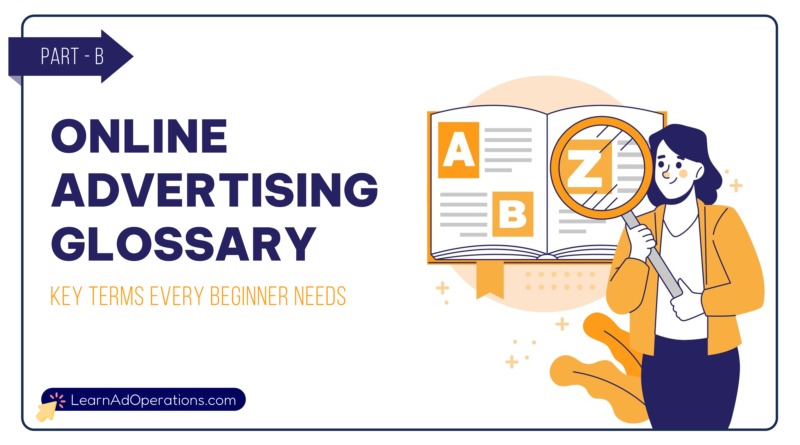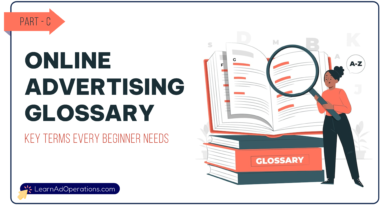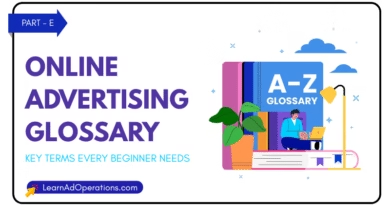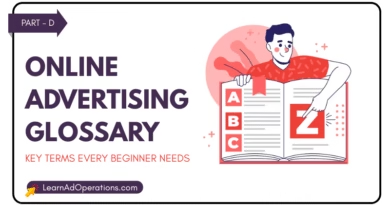Online Advertising Glossary for Beginners – Part 2
In the fast-paced world of digital marketing, mastering online advertising jargon is crucial for beginners aiming to excel. Our extensive Online Advertising Glossary is your ultimate resource for understanding digital advertising terms and concepts from A to Z.
Whether you’re exploring programmatic advertising, eCommerce advertising, performance marketing, or search engine marketing (SEM), this guide will help you quickly and effectively grasp the most important online advertising terminology.
By familiarizing yourself with these key terms, you’ll not only enhance your knowledge of digital advertising but also boost your ability to create successful digital marketing strategies.
Start navigating the complex landscape of online ads and improve your marketing acumen with our detailed glossary today!
B
Banner Ad: An online creative placed on a media owner’s digital property (e.g., a publisher’s webpage). A traditional display banner usually has a preset size (e.g., 300X250 pixels) and often includes a combination of images and text.
Base bid: The starting price that a marketer pays for an impression before applying bid factors.
Behavioral targeting: The practice of using browsing history to determine which ads would be relevant to individual users, and which ads to present them with on a particular website.
Bid: The offer made in an auction to pay for an impression. Can also refer to the final price or number of offers an advertiser makes.
Bid Price Optimization: Automatically adjusting the amount, a marketer will bid on a particular impression due to a variety of inputs that define the value of that impression to the marketer.
Bid factor: The multiplier applied to a base bid to increase or decrease the bid sent out in an ad exchange and adjusted based on individual customer characteristics. Can be applied to any vector, including device type, geo location, demographic. Ensures bids are adjusted to achieve an advertiser’s goals.
Bid request: The signal a supply-side platform sends to a demand-side platform that enables the latter to purchase ad inventory, as well as details about that impression.
Bid response: The signal a demand-side platform (DSP) sends to a supply-side platform in response to a bid request. In a bid response, the DSP indicates a bid price and, potentially, creative specifications.
Blocklist: A list of websites that an advertiser does not want its ads to appear on.
Brand lift: A way for advertisers to understand if their advertising is resulting in awareness, consideration, or purchase of their product or service. This is done by comparing a control group (not exposed to the ad) and exposed group (exposed to an ad), and measuring the difference between the two.
Brand Affinity: The likelihood of positive sentiment among a brand and a number of other elements (pages, people, other brands).
Brand Safety & Fraud Prevention: Brand Safety tools control automated optimizations to ensure a media owner or marketer’s definitions of acceptable content are applied to the media they sell or buy, respectively. Fraud Prevention refers to automated optimization to eliminate non-human traffic or false branding of media in which marketers are delivering advertising.
Bounce Tracking: Websites, such as authentication providers, credit card verification, and even Google and Facebook to track clicks on advertiser links within Search and ads in their digital properties. Both UID2 and Prebid SSO also rely on this technology to ensure user opt-in preferences can be communicated across the various sites people visit, despite the active interference by Internet Gatekeepers.
Broadcast TV: TV programming delivered via airwaves and accessible for free without a cable subscription.
Broadcast video on demand (BVOD): Streaming services offered by traditional TV broadcasters.
Budget: How much to spend on ads over a given time period.
Buy side: Advertisers, agencies, demand-side platforms, and data management platforms that purchase ad space online.
Buy: Purchasing ad space on relevant media channels at the optimal time and cost to achieve a pre-determined objective.
Buyer Index: AI-driven propensity models that unlock additional commerce media engagement opportunities. Buyer Index uses shopper intent data mapped to contextual signals to drive superior marketing outcomes.
B2B: B2B stands for Business to Business and refers to a business whose customers are other businesses (such as office furniture suppliers for example). Selling to businesses (as opposed to consumers) is very different, and a whole different set of tactics and strategies are needed for this type of business.
B2C: B2C means Business to Consumer and refers to a business whose customers are the general public (such as a supermarket for example).
Are you looking to learn Online Advertising jargons? Here is the comprehensive guide for beginners to learn digital marketing key terms from our Online Advertising Glossary.
Backlink: A backlink is a link from another website. Backlinks are different to inbound links, which are simply links from another webpage (whether or not they are on a different website).
Backup Ad: A Backup Ad is an ad that serves when an Ad Tag fails to call the intended ad.
Banner: The 468×60 ad unit is a now-defunct IAB standard ad unit with the dimensions of 468 pixels wide by 60 pixels tall. The 468×60 was retired in 2011 by the IAB.
Below The Fold: Below the Fold (or BTL) is ad placement placed at the bottom of the webpage. Users need to scroll down the webpages to see these ad units.
Source: The TradeDesk




